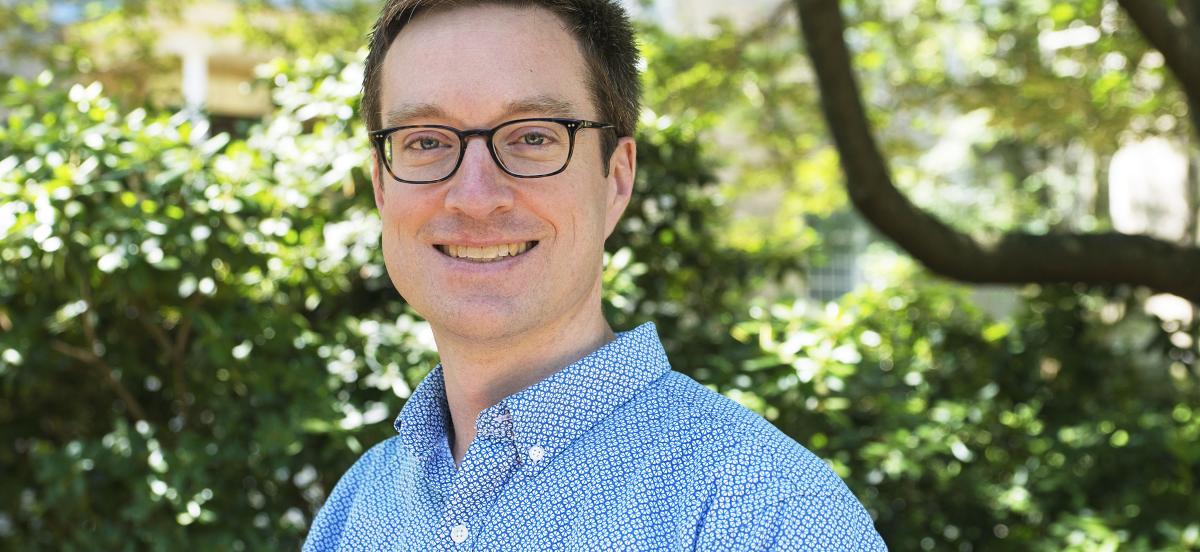Casey Londergan Awarded NSF Grant

Associate Professor of Chemistry Casey Londergan. Photo by Patrick Montero.
Details
The associate professor of chemistry has been awarded a $320,854 grant from the National Science Foundation to merge computational strategies with chemistry lab experiments to determine protein structures.
The National Science Foundation (NSF) has recognized Casey Londergan with a grant to fund his project, “RUI: Rigorous Physical Interpretation of Vibrational Probe Frequencies in Proteins.” This award will allow Londergan and his collaborators to continue his research on developing new tools to understand protein structure and dynamics.
"My lab has been working with ‘vibrational probe groups’ for some time now,” said Londergan. “These are unique chemical functional groups [specific arrangements of atoms] that vibrate at frequencies that we can observe using infrared or visible light and that change frequency depending on what's going on around them.”
Londergan’s lab uses a combination of computational and experimental approaches to examine these vibrational probe groups, and the new project supported by the NSF grant will allow for a more streamlined computational process and the opportunity for this unique problem-solving approach to be used by other chemists and researchers.
"This project makes our experiments much more quantitatively understandable,” he said. “We have been able to make some general conclusions in previous years, but the connection to computer simulations allows us to interpret our experimental results in much greater detail. This means that our ‘probe group’ approach, which has not yet been widely adopted, can be more confidently used by us and by others to understand dynamic protein structures.”
Part of this “probe group approach” includes the visualization of computer-generated “movies,” as Londergan calls them, which let researchers see the interactions between the chemical functional groups on screen.
"Our experimental approach, and the computer-simulated piece that now goes along with it, will be able to reveal new and important details of the molecular interactions in neurodegenerative diseases, cancer, and infectious diseases.”
The $320,854 grant will allow for the purchase of new lab supplies and equipment, including a new laser. Londergan also has received access to national supercomputer resources alongside this grant, and has been awarded 150,000 node hours over the next academic year on a national supercomputer to support the computational part of his work. The NSF funding also will support student involvement in Londergan’s research through summer stipends available through the KINSC Summer Scholars Program.
"I have had students involved in computational work for each of the last four years,” he said, “but this grant allows me to expand that part of my group into a new ‘computational subgroup’ of students with scientific computing interests who then can work directly alongside the experimental part of my group.”
Londergan looks forward to the opportunities for collaboration that this project provides, both on campus with other professors and students — he plans to include this research in the “Superlab” curriculum for junior chemistry majors — and across oceans with a group conducting similar research in Seoul, South Korea. Ultimately, he remains excited to uncover the potential of these “movies” and images of vibrational probe groups in better understanding how proteins work.
"As our students become more interested in computational research and as the College moves further in that direction, I am looking forward to expanding my group to involve not just chemistry, biology, and physics students, but also more students interested in computer science and applications of scientific computing,” said Londergan. “The computational aspect of our work should also lead us to some really interesting new visual ways to represent protein structure, and I'm looking forward to having some fun movies and pictures to show — as well as some dance moves that help to explain them.”



